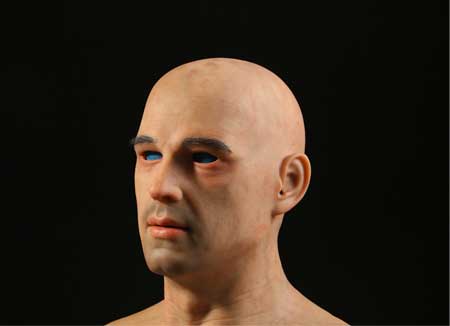Robot headgear
The playground robot headgear customized for the customer is placed on a simple manual inner mold, and the mouth and eye opening and closing are being tested
2020/6/30 8:45:33
Products used in life, including household appliances, kitchen supplies, and electronic products, will use silicone rubber products as accessories. Today, the physical characteristics of Top Dog silicone make silicone rubber products so popular.

1. Viscosity. Viscosity refers to the volumetric characteristics of liquids, pseudo-liquids or pseudo-solids that resist flow, that is, the internal friction or internal resistance between molecules when flowing under the action of external forces. Usually the viscosity is proportional to the hardness.
2. Hardness. The ability of a material to locally resist the pressing of hard objects into its surface is called hardness. Silicone rubber has a Shore hardness range of 10 to 80, which gives designers full freedom to choose the required hardness to best achieve a specific function. Various intermediate hardness values can be achieved by mixing polymer substrates, fillers and additives in different proportions. Similarly, the time and temperature of heat curing can also change the hardness without destroying other physical characteristics.
3. Tensile strength. Tensile strength refers to the force required per unit of range to cause a piece of rubber material to tear. The hot-vulcanized solid silicone rubber tensile strength range is between 4.0-12.5MPa. The tensile strength of fluorosilicone rubber is between 8.7-12.1MPa. The tensile strength of liquid silicone rubber ranges from 3.6-11.0MPa.
4. Tear strength. The resistance to the expansion of the incision or score when applying force to the sample with the incision. Even after being cut and placed under extremely high torsional stress, the heat-vulcanized solid silicone rubber will not be torn. The hot-vulcanized solid silicone rubber has a tear strength range of 9-55 kN/m. The tear strength of fluorosilicone rubber ranges from 17.5-46.4 kN/m. The tear strength of liquid silicone rubber ranges from 11.5-52 kN/m.
5. Elongation. Usually refers to the "limit elongation at break" or the percentage increase in the original length when the sample breaks. Hot vulcanized solid silicone rubber generally has an elongation range of 90 to 1120%. The elongation of fluorosilicone rubber is generally between 159 and 699%. The general elongation of liquid silicone rubber is between 220 and 900%. Different processing methods and choice of hardener can greatly change its elongation. The elongation of silicone rubber has a great relationship with temperature.
6. Operating time. The operating time is calculated from the moment the colloid is added to the vulcanizing agent. There is no complete limit between this operating time and the following curing time. The colloid has already undergone vulcanization reaction from the moment the vulcanizing agent is added. This operating time means that the 30-minute vulcanization reaction of the product does not affect the quality of the finished product. Therefore, the more time saved during the operation of the product, the more beneficial it is to the finished product.
7. Vulcanization time. In some places, it is said to be curing time. In other words, after such a long time, the vulcanization reaction of silica gel is basically over. This is basically over, which means that the product is already available, but in fact there is still a small part of the curing reaction has not yet ended. Therefore, products made of silicone rubber, such as silicone molds, are usually put in use for a period of time.

The playground robot headgear customized for the customer is placed on a simple manual inner mold, and the mouth and eye opening and closing are being tested

Medical aids customized by a German medical device company

Originally customized by Australian customers

Masks of middle-aged People in Europe and America are very popular

European and American young people mask, popular young people mask, popular

He is an old farmer in Europe and America, honest, authentic and friendly

Masks for young people in Europe and America, welcomed by customers

The best-selling style in Europe and America it is well received by users

European and American best-selling style, deeply loved by users